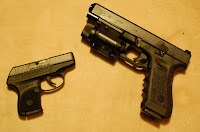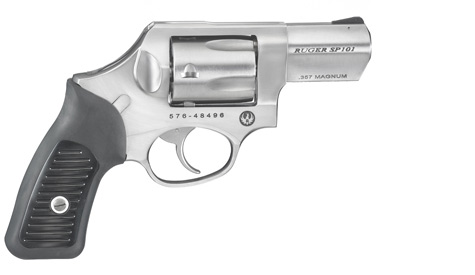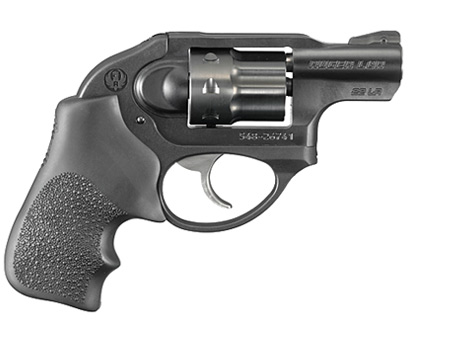I'll start off with something that may attract controversy- I typically don't recommend Taurus semi-automatic pistols. In my experience and research, they are hit and miss enough on quality and reliability for me not to recommend. They have a good reputation with revolvers (excepting the rimfire models) that I wouldn't hesitate to recommend one to someone looking to save some money. Their semi-auto pistol offerings have had some rough patches however, and for not much more money you can get something that has a reputation for reliability. In a carry gun something that is 100% reliable is very important. Therefore I'll only be recommending manufacturers that have a reputation for quality.
 |
| Double stack vs single stack magazine |
 | ||
| One of these is easier to conceal |
As a refresher, a single action trigger does 1 thing, it releases the hammer, which then strikes the firing pin. Most rifles and lots of handguns have single action triggers. When you cock a revolver that trigger is operating in single action mode, when you pull it it the only thing it is doing is releasing the hammer. Because of this single action triggers often have very light and short trigger pulls.
A double action trigger is doing two things. It is cocking the gun and then releasing the hammer or striker. Because it is doing a more complex mechanical activity, the trigger is often heavier, meaning it takes more effort or strength to pull, and it has a longer range of motion, or a longer pull. This gives a person a longer time to flinch or jerk. It also requires more strength and effort which can distract from a user focusing on the sights. You can certainly master a double action trigger, but you need to practice it, often practice a lot.
Now that I've covered the background, I'll offer my thoughts on common choices for concealed carry guns. What fits you and your style of carry is going to be different than what suits me and what suits your friend and what suits the instructor of your Concealed Carry class. It depends on body shape, hand shape, experience and where you can carry a gun. A skinny man can "appendix carry", a term describing a gun inside the waistband of a person's pants in that little sexy spot between his gentleman's region and his hip bone. A fuller figured man with a beer belly can't carry a gun there and would perhaps choose to carry a gun on their side (3 o'clock position) or even a bit behind at the 4 or 5 o'clock position. If a person has a big butt that affects where they can carry a gun. If a person dresses in tight clothing their options are limited vs someone who only wears clothes that tent or drape. So you will need to experiment to find the position and gun that is right for you.
Every gun mentioned here is meant to be carried in a holster. Don't carry a gun if it's not in a holster. Ever. It's a terrible idea. Don't do it.
Simple and cheap, the snub-nosed revolver
 | |
| S&W J-Frame, a good choice |
Most of the small revolvers sold are 38 specials. There are also a number of 357 magnums offered as well, but most people will be best served with shooting 38 special +P in a small snub-nose, whether you can shoot 357's or not.
Weights range from 12 ounces to 17 ounces for the ultra-light models. The gun in the picture to the right is a S&W 442 from their "Airweight" line and comes in at 15 ounces with a barrel just under 2". It also offers a DAO trigger and a shrouded hammer. Having the hammer encased in the frame is a good idea, as a hammer could snag as you draw your gun. The S&W 442 is a good choice in this category, especially considering they sell for $400 or less new. I'd be willing to bet Smith and Wesson isn't making any profit on these guns as they are well cheaper than any of their other revolver offerings.
 |
| Ruger SP101, another good choice |
Taurus also offers good quality small revolvers, both in light weight and full weight models. You can find some nice deals on used guns, but if you are buying new they are only $20 cheaper than the S&W 442 mentioned above. The S&W is an obvious choice for that small of a price differential. Charter Arms also offers a series of small revolvers in 38 special and 357, but like Taurus the prices are often very close to S&W. If you aren't going to save $50 or more on a Taurus or Charter Arms, then I suggest you go with the S&W.
 |
| S&W Bodyguard 38 |
So far I've only covered revolvers in the 38 special and 357 magnum varieties. These are the most popular and represent the majority of the guns sold. There are other calibers that may be right for you and I'll discuss those a bit. First is the 44 special. The 44 special is a big bullet moving slowly and it has a bit of a cult following. No one doubts the terminal effectiveness of the 44 special and many people find it reasonably pleasant to shoot. The Charter Arms Bulldog is a 21 ounce 5 shot revolver with a 2.5" barrel. It's a good choice for a carry gun. The down side is the ammo price is almost twice what 38 special costs. If you want to get good with a gun you have to practice and practice is going to be more expensive with a 44 special.
Another niche choice is 32 magnum or 327 magnum. (specifically 32 H&R magnum and 327 Federal magnum) These cartridges offer 38 special levels of energy but can be easier to shoot. You can also shoot 32 Long cartridges in either for practice loads. The downside to these cartridges is availability. They can be hard to find at your local store which means you may have to order them online or place an order with your local shop. They aren't prohibitively expensive except for the 327 round. But that can be considered the true magnum round and practice can take place with the 32 H&R magnum and 32 Long cartridges. But if you are having problems with recoil, finding a revolver in one of these cartridges could be a good idea. S&W, Ruger, Charter Arms and Taurus all offer a pistol in at least one of the 32 caliber cartridges. Since the cartridge is smaller in diameter they tend to hold 6 instead of 5.
 |
| The new Ruger LCR 22 |
Now, the 22 LR is not an ideal defensive cartridge. Honestly, neither is a 38 special or even a 44 magnum. If I know I will need to defend myself from an attacker I'm going to pick a tank as my weapon of choice. All handguns are a compromise, and hitting your target with a 22 is a lot more effective than missing with any other caliber. Don't let anyone talk you into buying a more powerful gun than you are comfortable with.
Ultra-light pocket 380 semi-auto pistols
 |
| Kel-Tec's 9oz 380, the P3-AT |
Full weight pocket 380 and 9x18 semi-auto pistols
 | |
| Walther PPK/S, very sexy |
Another option is the Sig P238 and Colt Mustang pistols. These are priced similarly to a PPK but in a form factor that is a bit smaller. These can be great choices, as they are as small as the smallest 380's but have a bit more weight and better triggers so they are easier to shoot. Colt only offers one model currently, Sig offers a wide variety of colors and finishes.
Small single-stack 9's
 |
| Kahr CM-9 |
 |
| Kimber Ultra-Carry II |
Small double-stack 9's
 |
| S&W M&P compact |
Other options
There are lots of other great options out there. Just because I didn't mention it here doesn't mean it's not a good choice. The Walther PPS, CZ Rami and Beretta NEOS all come to mind. I tried to capture the guns that are currently popular in the marketplace and easy to find from reputable manufacturers. If you think I've missed something major, please let me know and I'll consider adding it in. By no means is this intended as a comprehensive list.
I also only included 9mm in the semi-auto guns. In this post, and pretty much everywhere on the internet, when I say 9mm I mean the cartridge that is known as 9x19, 9mm Para, 9mm Parabellum, 9mm Luger and 9mm NATO (although NATO rounds are often a bit hotter than commercial rounds). It's the most affordable semi-auto round (other than 22) and most experts suggest it's powerful enough to do the job of self defense. There are lots of guns in other calibers, but for a person starting out 9mm allows them to practice more on less money than other calibers. It's the best choice. Maybe later on they may branch out to other calibers, but for new shooters 9mm is the best way to go. I don't dislike other calibers, it's strictly an economics thing. Heck, I'm in the process of making a kilt holster for my new carry gun chambered in 357 sig. I'm a big fan of other cartridges.
Other considerations
This post so far is a very basic introduction to the type of firearm one should consider when choosing to carry a gun for self-defense. There are a great many other considerations about the gun itself and other tools. Here is my Cliff Notes version on some other concealed carry thoughts.
Holsters - You want a good one that's made for your gun and covers the trigger. This may not be the first holster you buy. If you have friends who carry ask to try theirs out and see how they fit you. Never carry a gun without a holster.
Night Sights - Most conflicts happen at night. Bad guys are more likely to try to mug you, rape you or break into your house under cover of darkness. All other things being equal I'd rather have a gun that has night sights than one that doesn't. If you aren't familiar with night sights, they are sights that glow in the dark making it much easier to aim a gun in low light conditions.
Lasers - See night sights.
Gun mounted lights - See night sights. Being able to illuminate your target is better than not. However adding a light to a gun can make it harder to conceal and harder to find a holster for. I recommend anyone carrying a gun at least carries a light as well. If a shifty drunk is working your way on the sidewalk shining a bright light in their face doesn't break any laws and lets them know you aren't a victim.
Extra reloads - All things being equal, having a reload (extra magazine or cartridges) is better than not. However, unless you practice reloading I'd suggest you're better off using the reloading opportunity and time to escape the threat. If you haven't disabled the thread in your first x rounds, it seems unlikely that more will help. This isn't war we are preparing for, it's warding off an attacker or two. If you do carry an extra magazine or speed-loader you need to practice reloading in the dark and have it down to an art form if you expect to be able to do it while being attacked.
Bum Money - If a dude is drunk, high or desperate for his next fix, give them $20. It's not your job in society to put bad people down- if you can resolve a situation without violence that's the best way to go. So if you can hand a guy $20 and he goes away, that's a good solution. If you pull a gun you are escalating the situation and increasing the chance someone is going to get hurt, including you. If you shoot a man who is unarmed you may face charges. At the least if you discharge your gun in an altercation you're going to be processed at the police station. Be prepared to fight for your life, but don't view every situation as life or death. You aren't going to drive away a rapist with cash, but a robber you very well may.
Lastly, carry guns are going to wear. Just like your shoes, clothes and car wear out because you use them every day, expect for your gun to wear off it's finish. It may take years, but it's going to ugly up over time. Picking something pretty to carry every day is a recipe for disappointment.
No comments:
Post a Comment